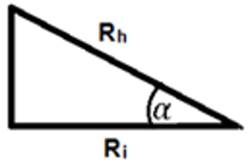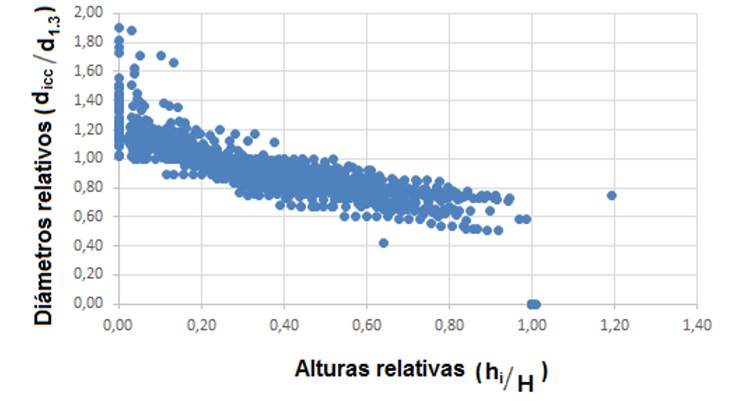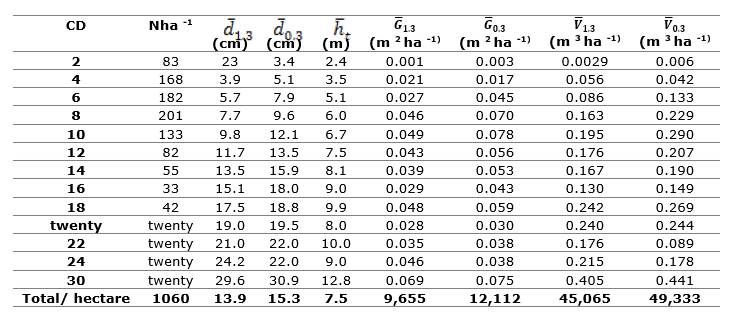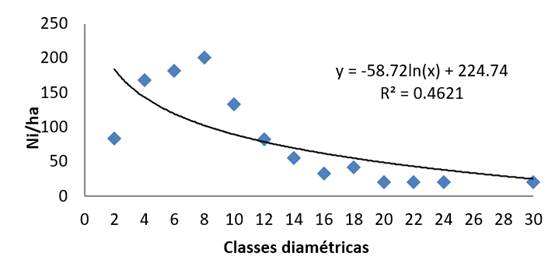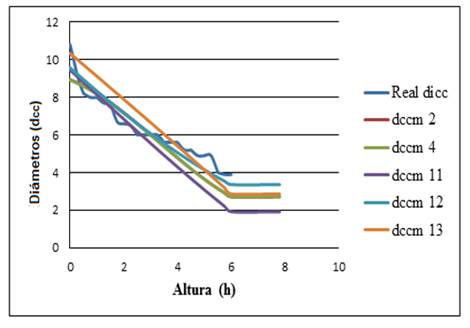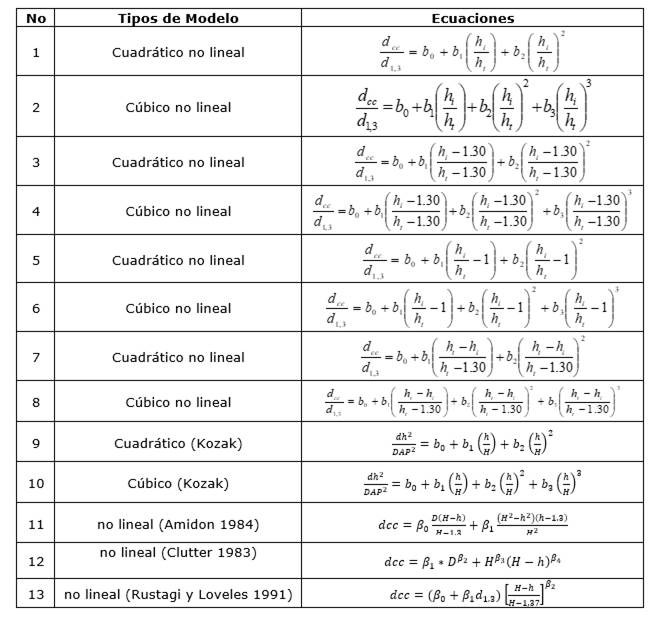Meu SciELO
Serviços Personalizados
Artigo
Indicadores
-
 Citado por SciELO
Citado por SciELO
Links relacionados
-
 Similares em
SciELO
Similares em
SciELO
Compartilhar
Revista Cubana de Ciencias Forestales
versão On-line ISSN 2310-3469
Rev CFORES vol.11 no.2 Pinar del Río maio.-ago. 2023 Epub 01-Ago-2023
Original article
Evaluation of stem profile models of the species Brachystegia floribunda (BENTH)
1Universidad de Pinar del Rio "Hermanos Saiz Montes de Oca". Pinar del Río, Cuba.
2Universidad de Guantánamo Facultad de Agronomía y Forestal. Guantánamo, Cuba.
Brachystegia floribunda (BENTH) has a high economic and social value for the peasant communities of Angola and several African countries. The stem taper or profile functions make it possible to estimate the diameter and/or volume at a given height of the tree, being, therefore, one of the dendrometric characteristics that defines the shape of the stem of forest species. Hence, the present study seeks to evaluate different mathematical models and determine the one with the best fit for the estimation of diameters and volume of this species. In total, 66 trees were felled and rigorously boxed, of which 53 were used to adjust the stem profile equations and 13 were used to validate the results obtained. Thirteen stem profile models were evaluated and the fit was examined from the comparison of the coefficient of determination, the root mean square error and a precision index. The Clutter non-linear model turned out to be the one with the best precision and, through its mathematical integration, allows obtaining an expression of the taper of the stem compatible with the commercial and total volume of standing trees. This equation is recommended to estimate the diameter and height per section of the stem, as well as the commercial and total volume of the studied species.
Key words: Stem taper; volumetric estimation; Clutter model; Stem profile; Shape Factor; Shape Quotient; Brachystegia floribunda.
INTRODUCTION
According to Sanfilippo (2014)Brachystégia floribunda (BENTH) is a common and exclusive tree species of the "Miombo" forest formation of the Central High Plan of Angola. It appears as an arboreal space with a trunk, generally straight and cylindrical, 6-19 cm in normal diameter at 1.3 m from the ground, with rough and irregular bark. According to the information obtained, it is an undemanding species in terms of soil quality that is generally found as a homogeneous population in soils poor in organic matter, ferralitic, which is characteristic of the region, well-drained and sandy. It produces round wood for rustic constructions and firewood for good quality charcoal. In the forestry aspect, it should be noted that the natural forest mass of Miombo in the village of Calombo where the present investigation was carried out, occupied its entire territorial extension, but gave way, in large part, to savannah plant communities due to human occupation.
The forest mass in the study area is characterized by being made up entirely of natural trees, forming forest patches where the three genera mentioned above predominate, with B. floribunda being one of the most representative species. In the Miombo formation of the Angolan Planalto and in the area that is the object of this research, recent works have been carried out and published by Frías Tamayo M. et al. (2021), Aldana and Lores (2021), Salvador JA N. et al. (2017).
Direct estimation of the volume of individual trees is crucial in forest inventories; for this reason, it is necessary to have mathematical expressions that allow modeling the taper and estimating the total or partial volumes of the stem, through easily measured variables.
According to Péllico (2017) there is extensive information based on the mathematical methodology used to improve the volumetry of trees, always based on the volume of regular solids.
The profile of the stem or taper of a tree is defined as the coefficient of narrowing of the diameter with the increase in height; therefore, the taper or profile functions describe the expected diameters, with or without bark, at different heights in the stem (Ramírez-Martínez A. et al., 2018).
The variation of the taper in the stem of the tree is caused by the natural conditions of growth, and by the response of the forest to the silvicultural treatments applied (Hernández-Pérez et al., 2013 and Uranga-Valencia et al., 2015). The taper can be described by means of a mathematical function that allows predicting the diameters at different heights of the stem; predict the height for a given stem diameter and predict the total volume of the stem or between different stem heights by integrating the model (López et al., 2016). Taper models are an important tool for determining timber stocks (by integrating the taper equation between two heights) and classifying standing tree products (Ramírez-Martínez A. et al., 2018).
According to Burkhart and Tomé (2012) there are several models that have been used to describe the stem profile, and they have been classified according to the complexity of the mathematical expressions, the number of variables and the coefficients of the model; the general classification is based on: general models for individual tree, segmented models and variable exponent models.
Stem profile analytical curve
The stem profile curves are mathematical functions that allow the average profile of the trees to be represented. The distribution of the diameter along its axis is known as the profile of the trunk or stem and as the curve of the taper of the stem is the curve with which it is intended to represent it; for its part, the directrix curve is the curve generated by a model.
The functions to describe the profile of the stem of the trees was a topic of great interest for foresters (Bi, 2000; Fang et al., 2000; Kozak, 2004). The construction of a volume equation for the classification of different products from a function of the stem profile is based on the capacity of this function to describe the diameter at different heights. Taking into account the application of the definite integral to calculate the volume of a solid of rotation, it is possible to determine the volume of wood between any two heights. Once the limit diameter up to which the volume is to be known is specified, its corresponding height is determined by analytically inverting the function or by means of some iterative procedure (Diéguez-Aranda et al., 2006 and Diéguez-Aranda et al., 2003).
The most widely used procedure for estimating individual volume is the use of equations in which volume is the dependent variable, associated with independent variables that are easy to measure in the forest, such as normal diameter at 1.3 m from the ground and height (Machado, 2002).
The most common approach on volume compatibles developed systems was carried out to express the β coefficient of Spurr `s combined variable equation, without the independent term
There must always be a function that represents the section of the shaft at different heights. Once this function is defined, the total volume of the piece or a part of it can be calculated between two heights h 1 and h 2. For example, Kozak (2004) used the model (Equation 1) for certain conifers.
Dónde:
d h |
= diameter at height h |
DAP |
= diameter at breast height |
h |
= height at which the diameter of a section is measured |
H |
= total height |
Pompas et al. (2009) tested six compatible taper models cited in the literature for Pinus arizonica engelm , whose expressions correspond to linear and non-linear equations.
Although there is abundant information on the taper of the stem profile of trees, there is little information on equations that describe the stem profile for broadleaf species, whether natural or planted, since most of the stem profile models have been tested on species of the genus Pinus.
Despite the efficiency of some equations, they do not always adjust to all forest species and conditions of forest populations, so it is advisable to test them, through statistical trials, and choose the model with the best result (Thomas, 2010).
Most of the methodologies developed for tree volume estimation consider that if the volume of a tree is correctly determined, the found value is valid for another tree of the same diameter, height and shape (Thiersch et al., 2006). The equations of tree taper with height for forest plantations are important to determine the products to be extracted from thinning or other silvicultural interventions. Forest products of different types can be objectively determined with these mathematical technologies. Currently, the functions of diameter taper with height are popular and efficient to represent the stem profile of trees and to estimate, by integration, commercial and total volumes (Clutter et al., 1983 and Návar, 2013).
There is little research on this subject in the forest species of the Miombo forest formation in the African countries where it exists. Therefore, the scientific problem to be solved in this research is related to the almost complete absence of stem profile for the main Miombo forest species. Hence the need to investigate in this line, with a view to finding models and stem profile equations that allow the precise estimation of the timber existence as support for the sustainable management of Miombo forests. Henceforth, the object of study is the stem profile models applied to the species B. floribunda (Benth) in a specific forest area of the Miombo formation.
The objective is to evaluate different mathematical models and determine the one with the best adjustment for the estimation of diameters and volume of B. floribunda.
MATERIALS AND METHODS
The present investigation was carried out in the village of Calombo in the Cuima Commune, Caála municipality, Huambo province in Angola, located approximately 25 km from Cuima between the geographical coordinates 13° 30' 12" South latitude and 15° 41' 24" East longitude.
To evaluate the dendrometric and dasometric characteristics, as well as the degree of occupation and productivity of the species B. floribunda, 32 circular plots of 500 m2 (0.05 hectare) with a radius of 12.62 m were raised. The correction of the radius of the plot was made so that its measurement was adjusted to a flat terrain. For this, the correction was made using the formula Ri= (Rh cos) á, where: Ri= Radius in the horizontal line; Rh= Radius on the slope line; α = Value of the slope measured in degrees (Figure 1).
For the analysis, a sample of 53 trees was used to fit different stem profile models, and 13 trees were used to validate the best fit model.
Each tree was felled and sectioned, making measurements of the normal diameter (d 1.3 ), diameter at the base (db), diameter of the stump at 0.3 m from the ground (d 0.3), diameters with bark at different heights "taper" (d icc), height (h i ) at different diameters (m) and total height (H) in m. All diameters were measured in cm.
In this study, 1107 pairs of diameters with bark and height data were used, which were obtained from 53 B. floribunda trees distributed in a range of diameter and height categories (Table 1) .
Table 1 presents the summary of the descriptive statistics of the trunk analyses.
Table 1. - Descriptive statistical values of the studied trees
| Variable | No. | Half | Standard deviation | Minimum | Maximum |
| db _ | 53 | 12.7 | 20,545 | 5 | 31.9 |
| d 0.3 | 53 | 11.9 | 21,176 | 4.5 | 30.9 |
| d 1.3 | 53 | 9.9 | 14,923 | 4 | 18.6 |
| h | 53 | 8.3 | 2,969 | 5 | 13.3 |
| dicc _ | 1107 | 8.8 | 19,766 | 0 | 23 |
| h i | 1107 | 3.2 | 5,451 | 0 | 1.0 |
The dispersion of the heights (hm/H) and diameters (dm/D) in relative terms is illustrated in Figure 2.
Tested stem profile models
A stem profile model is a mathematical expression that allows you to predict the diameter of a cross section at any height of the stem and to determine the volume of wood in any segment of the stem. For the adjustment of the stem profile equation, 13 mathematical models were evaluated, of which five are quadratic, five cubic and three non-linear. Eight of the tested models have as dependent variable d
cc
/d
1,3
, two have
These functions represent the section of the trunk at different heights and once defined allow the calculation of the total volume of the stem or part of it between two heights h i and h i+1Equation 2).
Where, in the models, d cc = diameter of the stem with bark at the relative height h (m);
For the adjustment of the stem profile functions, 1107 data of diameter and height corresponding to 53 trees were used. For the equations that required transformations, the statistical parameters were calculated with the necessary transformations.
A correlation analysis for the stem profile made it possible to determine the most correlated dependent and independent variables in the stem profile model.
To determine the validation statistics the determinant (R 2 ) coefficient, the standard error of the estimation (EEE) and the average bias were mainly used, which were calculated as follows Equation 3):
Where:
RESULTS AND DISCUSSION
The Microsoft Excel 2010 allowed calculating the main dendrometric and dasometric variables of the species B. floribunda. Among these variables are: number of trees per hectare
(Nha-1); average diameter at 1.3 m from the ground (d 1.3); diameter at 0.3 m from the ground (d ̅1.3); mean total height (h
t
); average commercial height (h c); mean basal area in m2 per hectare at 1.3 m above the ground
In general, in the area under study, the number of trees per hectare of diameter classes greater than 15 cm is very low.
Occupancy degree by diameter classes
In Table 3, it can be seen that the degree of occupation of B. floribunda (Benth) is high, since it occupies 42.9 % of the total number of trees per hectare of the forest mass, and also the average values of
Table 3. - Degree of occupation of B. floribunda in the forest area under study
| Parcel | N ha-1 | d ̅_(1.3) (cm) | d ̅_(0.3) (cm) | (/p) (m) | G ̅_(1.3) (m2ha-1) | G ̅_(0.3) (m2ha-1) | V ̅_(1.3) (m3ha-1) | V ̅_(0.3) (m3ha-1) |
| Average values per hectare of all species. | 2470 | 8.8 | 10.4 | 5.5 | 15.7 | 23.2 | 67.3 | 99.7 |
| Average values per hectare from |
1060 | 13.9 | 15.3 | 7.5 | 9,655 | 12,112 | 45,065 | 49,333 |
| % | 42.9 | 61.5 | 52.2 | 67.0 | 49.5 |
This species has a high energy value, which is why it is widely used in the production of charcoal and, according to previous data, it represents a high potential in terms of stocks in irregular Miombo forests for the production of charcoal.
Table 4 shows the percentage of trees in the respective diameter classes, where the highest percentages are observed between classes 4 and 10 with emphasis on diameter classes 8, 6 and 4, in that order respectively (Table 4).
Table 4. - Percentage of tree occupation by diameter classes of B. floribunda
| diameter classes | Nha -1 | % | diameter classes | Nha -1 | % |
| 2 | 83 | 8 | 16 | 33 | 3 |
| 4 | 168 | 16 | 18 | 42 | 4 |
| 6 | 182 | 17 | 20 | 20 | 2 |
| 8 | 201 | 19 | 22 | 20 | 2 |
| 10 | 133 | 13 | 24 | 20 | 2 |
| 12 | 82 | 8 | 30 | 20 | 2 |
| 14 | 55 | 5 | |||
| Total/ hectare | 1060 | 100 | |||
The diameter distribution of the number of trees per hectare presents the typical shape of irregular or multi-age forests, that is to say, that it has a negative exponential trend of inverted J, which means that the smaller diameter classes occur with a higher frequency of individuals than the smaller diameter superiors classes, this distribution guarantees the perpetuity of this natural forest (Figure 3).
This feature is common in most tropical forest formations and has been confirmed by Aldana (2010), but it had previously been explained by Scheffer et al. (1930 and Machado (2002).
Evaluation of the best profile model of the stem of B. floribunda
A correlation analysis of the diameter with bark (dcc) was carried out, measured in different sections along the stem, with respect to the other variables, in order to determine the dependent variable of the general model of the stem profile. The correlation matrix of this analysis is shown in Table 6. This Pearson bivariate correlation analysis allowed us to determine the variables most correlated with the diameter with bark (Table 5).
Table 5. - Pearson's bivariate correlation matrix of the dendrometric variables for the profile of the stem of B. floribunda
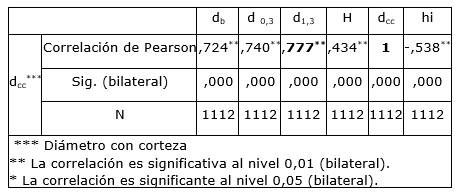
As observed in Table 5, Pearson's variables with the highest correlation are d
cc with itself and with d
1.3.. Therefore, the two most correlated variables were chosen, that is, the dependent variables of the model are
Determination of the predictive capacity and goodness of fit of the different models
With the application of SPSS Statists version 19, the statistical analysis was carried out, where the parameters, the correlations of the parameter estimates, the ANOVA and the descriptive statistics were estimated, which are basic for the determination of the goodness of fit and the prediction capacity of each model.
In Table 6, (see appendix 2) are the equations resulting from each stem profile model with the main statistical indices. In this table, in addition to the equations with the respective values of the regression coefficients, the following also appear: the correlation coefficient (R), the determination coefficient (R2), the standard deviation (Sx), the root of the error mean square and the aggregate difference. These statistical indices constitute the tool to decide, according to their behavior, which of the tested models will have the best goodness of fit and predictive capacity. Table 6 shows the equations of the five models with the best goodness of fit and predictive capacity.
For the evaluation of each of the five selected models, the tree with the largest number of sections was chosen from the database of the 13 trees defined for validation, and then the diameter of each section was estimated. The calculation of the three statistical indices; Mean bias, Coefficient of determination (R 2) and Standard Error of Estimates (SEE), allowed to carry out the validation and determine the best model of the profile of the stem of the species B. floribunda, whose formulas are (Equation 4):
Table 6 shows the statistical validation results of the five models, where it can be seen that model 12, represented by equation
Table 7. - Validation statistics of the 5 best stem profile models of B. floribunda
| Statistical indices | model 2 | model 4 | model 11 | model 12 | model 13 |
| mean bias | 0.152 | 0.173 | 0.505 | -0.099 | -0.535 |
| R2 _ | 0.803 | 0.804 | 0.707 | 0.839 | 0.710 |
| EEA | 0.872 | 0.869 | 1,031 | 0.787 | 1,041 |
The graphical representation of the stem profile with each of the five models (Figure 4) shows that models 12 and 13 are the closest to the real value. Therefore, it can be concluded that the equation
CONCLUSIONS
B. floribunda is the most represented species in the study area with 42.9% of the total number of trees per hectare, 61.5 % and 52.2 % of the basal area per hectare at 1.3 and 0.3 m from the soil respectively, as well as 67.0 and 49.5 % of the average volume per hectare at 1.3 and 0.3 m from the soil respectively.
In the same way, the mean diameters at 1.3 and 0.3 m from the ground and mean total height are 1.6; 1.5 and 1.4 times higher than the average values of all the species inventoried in the area.
Of the 13 adjusted stem profile models, the non-linear model by Clutter (1983) was the best, whose general formula
Appendix 1 (Table 8).
Appendix 2 (Table 9).
Table 9 - Models evaluated in the species B. floribunda to select the one with the best goodness of fit and predictive capacity

Appendix 5 (Table 10).
REFERENCIAS BIBLIOGRÁFICAS
ALDANA PEREIRA, E., 2010. Medición forestal [en línea]. La Habana: Félix Varela. ISBN 978-959-07-1321-7. Disponible en: https://books.google.com.cu/books/about/Medici%C3%B3n_forestal.html?id=Pv6OswEACAAJ&re%20dir_esc=y. [ Links ]
ALDANA PEREIRA, E., y LORES PÉREZ, Y., 2021. Factor y cociente de forma preliminar de Brachystegia floribunda Benth. Revista Cubana de Ciencias Forestales [en línea], vol. 9, no. 1, pp. 124-139. [Consulta: 06/03/2023]. ISSN 2310-3469. Disponible en: Disponible en: https://cfores.upr.edu.cu/index.php/cfores/article/view/637 . [ Links ]
ÁLVAREZ GONZÁLEZ, J.G., ÁLVAREZ TABOADA, M.F., BARRIO ANTA, M., CASTEDO DORADO, F., DIÉGUEZ ARANDA, U., ROJO ALBORECA, A. y RUIZ GONZÁLEZ, A.D., 2003. Dendrometría [en línea]. España: Ediciones Mundi-Prensa. ISBN 978-84-8476-145-7. Disponible en: https://books.google.com.cu/books?id=25dwscrGdeMC&printsec=frontcover&hl=es&source=gbs_ge_summary_r&cad=0#v=onepage&q&f=false. [ Links ]
AMARAL MACHADO, S. do., BARBOSA DA CONCEIÇÃO, M., y FIGUEIREDO, D.J. de, 2002. Modelagem do volume individual para diferentes idades e regimes de desbaste em plantações de Pinus oocarpa. RECEN-Revista Ciências Exatas e Naturais [en línea], vol. 4, no. 2, pp. 185-197. [Consulta: 06/03/2023]. ISSN 2175-5620. Disponible en: Disponible en: https://revistas.unicentro.br/index.php/RECEN/article/view/462 . [ Links ]
BURKHART, H., y TOMÉ, M., 2012. Modeling forest trees and stands [en línea]. Estados Unidos: Springer. ISBN 978-94-007-1597-4. Disponible en: https://www.researchgate.net/publication/235004853_Modeling_Forest_Trees_and_Stands. [ Links ]
CLUTTER, J.L., 1983. Timber Management: A Quantitative Approach [en línea]. Estados Unidos: Wiley. ISBN 978-0-471-02961-8. Disponible en: https://books.google.com.cu/books/about/Timber_Management.html?id=RSbxAAAAMAAJ&redir_esc=y. [ Links ]
DIÉGUEZ ARANDA, U., CASTEDO DORADO, F., ÁLVAREZ GONZÁLEZ, J., y ROJO ALBORECA, A., 2006. Compatible taper function for Scots pine plantations in northwestern Spain. Canadian Journal of Forest Research [en línea], vol. 36, no. 5, pp. 1190-1205. DOI 10.1139/x06-008. Disponible en: https://www.researchgate.net/publication/237866454_Compatible_taper_function_for_Scots_pine_plantations_in_northwestern_Spain. [ Links ]
FANG. BORDERS, B., y BAILEY, L., 2000. Compatible Volume-Taper Models for Loblolly and Slash Pine Based on a System with Segmented-Stem Form Factors. Forest Science [en línea], vol. 46, no. 1, pp. 1-12. Disponible en: https://www.researchgate.net/publication/233512687_Compatible_Volume -Taper_Models_for_Loblolly_and_Slash_Pine_Based_on_a_System_with_Segmented -Stem_Form_Factors. [ Links ]
FRÍAS TAMAYO, M., PEREIRA JAY, N.F., y ALDANA PEREIRA, E., 2021. Evaluación preliminar de la eficacia del método con probabilidad variable en bosque de Miombo. Revista Cubana de Ciencias Forestales [en línea], vol. 9, no. 2, pp. 193-204. [Consulta: 06/03/2023]. ISSN 2310-3469. Disponible en: Disponible en: https://cfores.upr.edu.cu/index.php/cfores/article/view/635 . [ Links ]
HERNÁNDEZ PÉREZ, D., SANTOS POSADAS, H.M. de los., ÁNGELES PÉREZ, G., VALDEZ LAZALDE, J.R., y VOLKE HALLER, V.H., 2013. Funciones de ahusamiento y volumen comercial para Pinus patula Schltdl. et Cham. en Zacualtipán, Hidalgo. Revista Mexicana de Ciencias Forestales [en línea], vol. 4, no. 16, pp. 34-45. [Consulta: 06/03/2023]. Disponible en: Disponible en: https://www.redalyc.org/articulo.oa?id=63433990004&idioma=en . [ Links ]
HUIQUAN BI, 2000. Trigonometric variable-form taper equations for Australian eucalypts. Forest science [en línea], vol. 46, no. 3, pp. 397-409. ISSN 0015-749X. Disponible en: https://pascal-francis.inist.fr/vibad/index.php?action=getRecordDetail&idt=1531809. [ Links ]
KOZAK, A., 2004. My last words on taper equations. The Forestry Chronicle [en línea], vol. 80, no. 4, pp. 507-515. DOI 10.5558/tfc80507-4. Disponible en: https://www.researchgate.net/publication/272900236_My_last_words_on_taper_equations. [ Links ]
LÓPEZ AGUIRRE, A., BARRIOS, A., y TRINCADO, G., 2016. Modelos de perfiles fustales con una estructura de error autorregresiva para plantaciones de Eucalyptus tereticornis en Colombia. Madera y Bosques [en línea], vol. 21, no. 2. DOI 10.21829/myb.2015.212446. Disponible en: https://www.researchgate.net/publication/309138157_Modelos_de_perfiles_fustales_con_una_estructura_de_error_autorregresiva_para_plantaciones_de_Eucalyptus_tereticornis_en_Colombia. [ Links ]
NANVONAMUQUITXO, S.J.A., GÓNGORA ROJAS, F., y HOFIÇO, N.D.S.A., 2017. Estructura y composición floristica de un bosque nativo de Miombo en el Distrito de Mocuba Provincia Zambezia, Mozambique. Revista Cubana de Ciencias Forestales [en línea], vol. 5, no. 2, pp. 140-152. [Consulta: 06/03/2023]. ISSN 2310-3469. Disponible en: Disponible en: https://cfores.upr.edu.cu/index.php/cfores/article/view/229 . [ Links ]
NÁVAR, J., RODRÍGUEZ FLORES, F. de J., y DOMÍNGUEZ CALLEROS, P., 2013. Taper functions and merchantable timber for temperate forests of northern Mexico. Annals of Forest Research [en línea], vol. 56, no. 1, pp. 165-178. DOI 10.15287/afr.2013.51. Disponible en: https://www.researchgate.net/publication/286642601_Taper_functions_and_merchantable_timber_for_temperate_forests_of_northern_Mexico. [ Links ]
OLIVEIRA, A.D. de., DEHON, G., SCOLFORO, J.R., THIERSCH, C., y MAESTRI, R., 2006. Acurácia dos métodos para estimativa do volume comercial de clones de Eucalyptus sp. Cerne [en línea], vol. 12, no. 2, pp. 167-181. Disponible en: https://www.researchgate.net/publication/237039557_Acuracia_dos_metodos_para_estimativa_do_volume_comercial_de_clones_de_Eucalyptus_sp. [ Links ]
PÉLLICO NETTO, S., 2017. Equivalência volumétrica: uma nova metodologia para estimativa do volume de árvores. Revista Académica: Ciencia Animal [en línea], vol. 2, no. 1, pp. 17. DOI 10.7213/cienciaanimal.v2i1.15003. Disponible en: https://www.researchgate.net/publication/321284406_Equivalencia_volumetrica_uma_nova_metodologia_para_estimativa_do_volume_de_arvores. [ Links ]
POMPA GARCÍA, M., CORRAL RIVAS, J.J., DÍAZ VÁSQUEZ, M., y MARTÍNEZ SALVADOR, M., 2009. Función de ahusamiento y volumen compatible para Pinus arizonica Engelm. En el Suroeste de Chihuahua. Ciencia forestal en México [en línea], vol. 34, no. 105, pp. 117-134. Disponible en: https://www.researchgate.net/publication/262448053_Funcion_de_ahusamiento_y_volumen_compatible_para_Pinus_arizonica_Engelm_En_el_Suroeste_de_Chihuahua. [ Links ]
RAMÍREZ MARTÍNEZ, A., SANTIAGO GARCÍA, W., QUIÑONEZ BARRAZA, G., RUIZ AQUINO, F., y ANTÚNEZ, P., 2018. Modelación del perfil fustal y volumen total para Pinus ayacahuite Ehren. Madera y Bosques [en línea], vol. 24, no. 2. DOI 10.21829/myb.2018.2421496. Disponible en: https://www.researchgate.net/publication/325461053_Modelacion_del_perfil_fustal_y_volumen_total_para_Pinus_ayacahuite_Ehren. [ Links ]
SANFILIPPO, M., 2014. Trinta árvores e arbustos do miombo Angolano - Guia de campo para a identificação [en línea]. Italia: COSPE. [Consulta 06/03/2023]. Disponible en: Disponible en: http://www.bibliotecaflorestal.ufv.br/handle/123456789/14828 . [ Links ]
SCHEFFER, A., GAZIN, A., y ALVERNY, A. D., 1930. Sapinières. Paris: Lwes Presses Universitieres de France. [ Links ]
SHARMA, M., y ODERWALD, R., 2011. Dimensionally compatible volume and taper equations. Canadian Journal of Forest Research [en línea], vol. 31, no. 5, pp. 797-803. DOI 10.1139/x01-005. Disponible en: https://www.researchgate.net/publication/237865757_Dimensionally_compatible_volume_and_taper_equations. [ Links ]
THOMAS, C., ANDRADE, C., SCHNEIDER, P., y FINGER, C., 2010. Comparação de equações volumétricas ajustadas com dados de cubagem e análise de tronco. Ciencia Florestal [en línea], vol. 16, no. 3. DOI 10.5902/198050981911. Disponible en: https://www.researchgate.net/publication/27790615_Comparacao_de_equacoes_volumetricas_ajustadas_com_dados_de_cubagem_e_analise_de_tronco. [ Links ]
URANGA VALENCIA, L.P., DE LOS SANTOS POSADAS, H.M., VALDEZ LAZALDE, J.R., LÓPEZ UPTON, J., y NAVARRO GARZA, H., 2015. Volumen total y ahusamiento para Pinus patula Schiede ex Schltdl. et Cham. en tres condiciones de bosque. Agrociencia [en línea], vol. 49, no. 7, pp. 787-801. [Consulta: 06/03/2023]. ISSN 1405-3195. Disponible en: Disponible en: https://dialnet.unirioja.es/servlet/articulo?codigo=5425690 . [ Links ]
Received: January 30, 2023; Accepted: June 16, 2023











 texto em
texto em 

